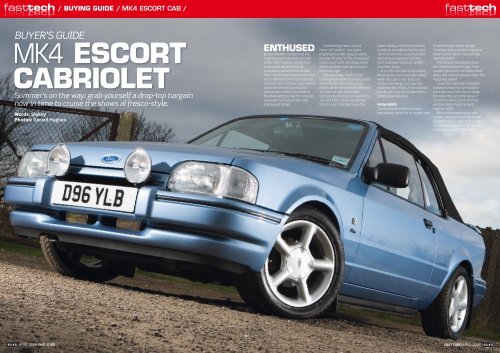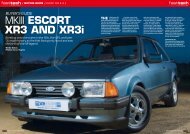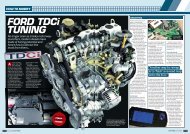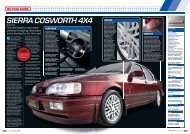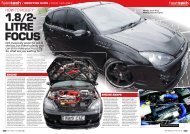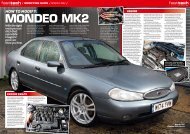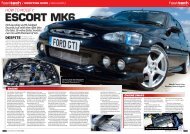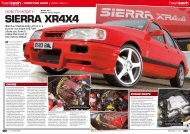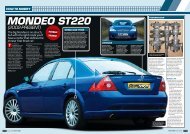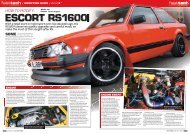MK4 ESCORT CABRIOLET - Fast Ford
MK4 ESCORT CABRIOLET - Fast Ford
MK4 ESCORT CABRIOLET - Fast Ford
You also want an ePaper? Increase the reach of your titles
YUMPU automatically turns print PDFs into web optimized ePapers that Google loves.
fasttech / BUYING GUIDE / <strong>MK4</strong> <strong>ESCORT</strong> CAB / fasttech<br />
BUYER’S GUIDE<br />
<strong>MK4</strong> <strong>ESCORT</strong><br />
<strong>CABRIOLET</strong><br />
Summer’s on the way: grab yourself a drop-top bargain<br />
now in time to cruise the shows al fresco-style.<br />
Words: Blakey<br />
Photos: Gerard Hughes<br />
ENTHUSED<br />
by the fantastic reception to the<br />
original Escort Cabriolet concept<br />
at the 1981 Frankfurt show, <strong>Ford</strong><br />
announced the arrival of its<br />
production version in December<br />
1983. The finished model didn’t look<br />
much different to the concept and<br />
truth be told, <strong>Ford</strong> was much further<br />
down the line with production<br />
plans than it had let on, those in<br />
the know spotted that the concept<br />
was expertly finished with wellengineered<br />
details.<br />
Considering it was ‘almost<br />
there’ at Frankfurt, two years<br />
might seem a little long to realise<br />
the specification of the completed<br />
cabrio, but <strong>Ford</strong>’s SVE department<br />
and co-builders Karmann knew it<br />
had to be right.<br />
Unsurprisingly, much of the<br />
development work revolved around<br />
restoring the loss in structural<br />
rigidity when the roof was removed.<br />
So, a pair of rails was added<br />
beneath the floorpan alongside the<br />
sills and extra metal was grafted<br />
into the rear bulkhead area, the<br />
latter making a shelf for the hood<br />
as well as strengthening the shell.<br />
The front and rear crossmembers<br />
were braced together with the<br />
front bulkhead and door upright<br />
mounting posts.<br />
A chunky roll-over hoop added<br />
extra rigidity and passenger safety,<br />
while the cabrio also featured<br />
unique rear wings and speciallymade<br />
bootlid. In fact, <strong>Ford</strong> claimed<br />
that 80 per cent of the cabriolet’s<br />
sheet metal was new.<br />
IN DA HOOD<br />
The double-skinned hood was<br />
particularly noted for its quality and<br />
fit and through clever design,<br />
<strong>Ford</strong> was able to avoid a massive<br />
hood ‘hump’ when the roof was<br />
lowered down.<br />
And despite the decent-sized<br />
rear side windows though, <strong>Ford</strong><br />
couldn’t avoid the inevitable blind<br />
spots that were produced when the<br />
hood was raised.<br />
Under the cabriolet’s bespoke<br />
bodywork was the running gear<br />
from the rest of the Escort range,<br />
the initial line-up comprising of<br />
1.3 and 1.6-litre carb’d versions<br />
and the XR3i-influenced and<br />
engined 1600i.<br />
While Volkswagen stuck with<br />
its Mk1 cabriolet when the model<br />
evolved into the Mk2, <strong>Ford</strong> chose to<br />
update the cabriolet when the Mk3<br />
Escort gave way to the Mk4.<br />
0 1 4 2 APRIL 2006 FAST FORD FAST FORD APRIL 2006<br />
0 1 4 3
fasttech / BUYING GUIDE / <strong>MK4</strong> <strong>ESCORT</strong> CAB / fasttech<br />
Rear wings and<br />
bootlid are unique<br />
to the Cabriolet<br />
STYLE COUNCIL<br />
Like its brethren, the 1986<br />
cabriolet benefited from smoother,<br />
more rounded styling and there<br />
was also the option of the SCS<br />
Lucas-Girling anti-lock braking<br />
system. The 1.3-litre-engined Mk3<br />
cabrio had never sold well, so in<br />
facelifted Mk4 guise <strong>Ford</strong> offered<br />
just two models — the 90 bhp<br />
1.6-litre Ghia and 105 bhp XR3i<br />
version.<br />
Disappointing sales meant the<br />
Ghia was dropped at the end of<br />
1987 but while this model didn’t<br />
Original wheels were<br />
steels or latticespoke<br />
alloys on the<br />
XR3i. These are from<br />
a later Escort Si<br />
find favour with car buyers, they<br />
couldn’t get enough of the opentop<br />
XR3i.<br />
The cabrio really looked the part<br />
with the trademark XR bumpers,<br />
driving lamps and ‘dogleg’ alloys<br />
and even more pose value was<br />
added in the winter of 1987 when<br />
<strong>Ford</strong> announced the option of a<br />
power-operated hood.<br />
The options list continued to<br />
grow with a Quickclear windscreen<br />
and leather trim. <strong>Ford</strong> amalgamated<br />
these desirable extras into limitededition<br />
models. These cars included<br />
the ‘All-White’, ‘Duo-Tone’ and the<br />
commemorative ‘All-Blue’ model,<br />
which appeared in spring 1990<br />
and celebrated the production of<br />
100,000 cabriolets.<br />
KEEP ON RUNNING<br />
Aside from the optional ABS and<br />
minor changes to the suspension,<br />
the running gear of the Mk4 XR3i<br />
cabriolet was largely unaltered from<br />
the earlier Mk3 1600i.<br />
However, a significant change<br />
came in 1989 when the Bosch<br />
fuel injection was dropped in<br />
favour of <strong>Ford</strong>’s own EEC-IV<br />
fuel injection and engine<br />
management. These later<br />
XR3i cabriolets were easily<br />
identifiable by the EFi logo<br />
emblazoned on the castalloy<br />
inlet manifold, and the<br />
change included revisions<br />
to the cylinder head and<br />
camshaft timing, new plastic<br />
sections to the air intake<br />
induction running over the<br />
rocker cover, altered manifold<br />
and gas-flowed intake ports.<br />
<strong>Ford</strong> did the work in the<br />
interests of emissions and<br />
enabling the Escort to run on<br />
unleaded 95 octane fuel, but the<br />
changes also gave an increase of 3<br />
bhp, lifting peak power to 108 bhp.<br />
The cabby had its flaws — the<br />
boot was relatively small and it was<br />
less powerful than the larger-engined<br />
Golf GTi cabrio — but <strong>Ford</strong> hit upon a<br />
winner with the Mk4.<br />
If you needed any evidence of<br />
just how good the Escort was as a<br />
INFORMATION<br />
HPI<br />
Back in the day, the Escort Cabriolet<br />
was a firm favourite with the illegal<br />
car trade, its high demand and<br />
strong values made it ripe for ringing<br />
and cutting and shutting.<br />
So, avoid getting yourself landed<br />
with a moody example by stumping<br />
up for an HPI check. It’ll cost you<br />
£39.99 if you do it online at www.<br />
hpi.co.uk or £42.95 if you want a<br />
nice operator to conduct the check<br />
over the phone on 01722 422422.<br />
If you’re looking at splashing<br />
nearly three grand on the very best<br />
example, consider an independent<br />
inspection. The RAC’s Essentials<br />
Plus inspection costs £204.95 for<br />
members and £227.95 for nonmembers.<br />
A cheaper option is the<br />
Essentials check, which highlights<br />
any major accident damage and<br />
“Enjoy open-top<br />
motoring for as little as<br />
a few hundred quid.”<br />
complete package, then it’s the fact<br />
that it sold so well without being a<br />
particular bargain. Even the entrylevel<br />
1.6-litre Ghia cost over £10,000<br />
in 1986 and the price continued to<br />
spiral over the years, culminating<br />
in the 1990 All-Blue’s eye-watering<br />
price of £16,500.<br />
It’s a different story 16 years later<br />
though. Values of the Mk4 cabrio<br />
have hit rock bottom and you can<br />
also covers overall mechanical and<br />
structural condition. This check<br />
costs £124.95 for members and<br />
£134.95 for non-members. Call the<br />
RAC on 0870 5333660 or log onto<br />
www.rac.co.uk.<br />
INSURANCE<br />
Paul is 29-year-old mechanic from<br />
High Wycombe. He wants to build<br />
an RS Turbo-powered cabby for<br />
the summer, so to get him on<br />
the right track he’s picked up a<br />
very nice and tidy 1988 E-reg<br />
XR3i Cabriolet.<br />
The Cat 2-alarmed Escort is<br />
well taken care of being garaged<br />
every night and although it’s his<br />
daily driver, the cabriolet is going<br />
to stay in pretty good shape as<br />
Paul’s a very careful driver with<br />
four years no claims bonus and a<br />
clean licence.<br />
Mk4 Ghias were only<br />
made between 1986-<br />
87. Most survivors<br />
are the XR3i version<br />
enjoy open-top motoring for as little<br />
as a few hundred quid.<br />
It’s hardly the height of cool in<br />
2006, but drop the hood during the<br />
summer months and the smiles-<br />
per-pound value of the cabrio is<br />
immense. Don’t forget, having fun<br />
is what owning a fast <strong>Ford</strong> is all<br />
about, but if there’s the opportunity<br />
to enjoy a bit of sun then the<br />
experience is all the more sweeter.<br />
In its current standard spec,<br />
Paul pays £403.20 to insure his<br />
Escort fully comprehensive or<br />
£359.10 for third party, fire and<br />
theft cover.<br />
Quote provided by www.<br />
directline.com.<br />
CLUB<br />
XR Owners’ Club<br />
XROC HQ<br />
9 Cope Place, Earls Court Road<br />
Kensington<br />
London<br />
W8 6AA<br />
020 7937 7595<br />
www.xroc.co.uk<br />
<strong>Ford</strong> Escort Owners’ Club<br />
www.feoc-uk.com<br />
Escort Cabriolet Club<br />
www.escortcabrioletclub.co.uk<br />
TECH SPEC<br />
XR3i <strong>CABRIOLET</strong><br />
ENGINE<br />
Type: CVH<br />
Capacity: 1596cc<br />
Bore/stroke: 79.96 mm x 79.52 mm<br />
Compression ratio: 9.5:1<br />
Max power: 105 bhp @ 6000 rpm<br />
(108 bhp for EFi engine)<br />
Max torque: 102 Ibf.ft @4800 rpm<br />
Cylinders: four, in-line<br />
Cylinder head: alloy<br />
Block: cast iron<br />
Installation: front-mounted,<br />
transverse<br />
Valve gear: two valves per<br />
cylinder, single overhead camshaft<br />
driven by external toothed belt,<br />
rockers, hydraulic lifters<br />
Fuelling: Bosch K-Jetronic fuel<br />
injection (<strong>Ford</strong> EEC IV engine<br />
management/injection from<br />
September 1989)<br />
Injection: <strong>Ford</strong> contactless<br />
electronic ignition<br />
TRANSMISSION<br />
Type: fwd<br />
Gearbox: <strong>Ford</strong> type-B5 five-<br />
speed manual<br />
Internal ratios: 1st, 3.15:1;<br />
2nd, 1.9:1; 3rd, 1.27:1; 4th, 0.95:1;<br />
5th, 0.76:1.<br />
Final drive: 3.58:1<br />
Clutch: 190 mm single plate clutch<br />
SUSPENSION<br />
Front: MacPherson struts, coil<br />
springs, telescopic dampers and<br />
24 mm anti-roll bar<br />
Rear: independent by coil<br />
springs, lower wishbones, radius<br />
arms, and telescopic dampers<br />
STEERING<br />
Type: rack-and-pinion<br />
Lock-to-lock: 3.7 turns<br />
BRAKES<br />
System: hydraulic, with vacuum<br />
servo assistance<br />
Optional Lucas-Girling SCS anti-<br />
lock braking<br />
Front: 9.4 inch (239 mm) vented discs<br />
Rear: 8x1.5 inch (203x38 mm) drums<br />
WHEELS & TYRES<br />
Wheels: 6x14 steel or five-<br />
spoke alloy wheels, steels with<br />
pearlescent trims<br />
Tyres: 185/60 HR14<br />
BODY<br />
Type: pressed-steel mono-<br />
coque two-door Escort Mk4<br />
convertible shell<br />
PERFORMANCE<br />
Max speed: 115 mph<br />
0-60 mph: 9.6 seconds<br />
FAST FORD APRIL 2006<br />
0 1 4 4 APRIL 2006 FAST FORD 0 1 4 5
fasttech / BUYING GUIDE / <strong>MK4</strong> <strong>ESCORT</strong> CAB / fasttech<br />
CHECKLIST<br />
ENGINE<br />
It’s not particularly willing or refined, but the cab’s<br />
1596cc CVH is tough and relatively powerful. Treat<br />
it right and it’ll happily soldier on to six-figure<br />
mileage, but skimp on the basics and it’ll expire<br />
in a hot and oily mess.<br />
Regular oil and cambelt changes are the<br />
key to keeping the CVH alive. Ignore the oil,<br />
and the hydraulic lifters sludge up. If the<br />
cambelt breaks it can trash the whole head.<br />
Plumes of blue or white smoke are bad<br />
news — blue is oil being burnt in the<br />
combustion chambers while white usually<br />
indicates a blown head gasket.<br />
The majority are fuel-injected but<br />
you might find a rare carb-fed Ghia<br />
model. Both fuelling methods are<br />
reliable but will cost to put right if<br />
they’re running rough, and any<br />
glitches in the injection will need<br />
sorting by an expert. Of the two, it is<br />
the later EEC-IV set-up that can prove<br />
troublesome, suffering from a rough idle.<br />
TRANSMISSION<br />
BC gearbox is longlasting<br />
in the Cab<br />
The five-speed BC isn’t <strong>Ford</strong>’s slickest<br />
shifter but it’s a hardy unit that comfortably<br />
copes with the power of the cabriolet’s<br />
1600 CVH, whether in carburettor or<br />
injected form. But, while it can shrug off<br />
the grunt of the motor, the transmission<br />
can do little about the wear that escalates<br />
as the miles pile on. Expect a bit of whine<br />
and some slop in the linkage of higher<br />
mileage cars, but if gears need to be forced<br />
home and there’s any noticeable rumbling<br />
then something is amiss.<br />
The synchromesh can also break down<br />
over time and the obvious indication is<br />
crunching between gears, particularly on<br />
the second to third gearshift. Check for<br />
clutch slip too as the majority of cabriolets<br />
will be showing at least 70K miles, making<br />
them ideal candidates for new clutches. A<br />
simple test is to try and pull away in third<br />
gear from a standstill, if the car stalls then<br />
the clutch is working as it should.<br />
Carb-fed Ghias are rare:<br />
most use fuel-injection<br />
INTERIOR<br />
BODYWORK<br />
The Mk4 Escort loves to rot and the<br />
cab is no exception. Rust is likely on<br />
the front wings and rear arches, while<br />
the bootlid and door edges go as drain<br />
holes get blocked. Look at the panel<br />
below the hood, as this often rots out.<br />
Inspect inner wings and suspension<br />
turrets, bulkhead, battery tray, sills,<br />
chassis rails and the floorpan. Genuine<br />
<strong>Ford</strong> panels are hard to source, but<br />
remanufactured aftermarket parts<br />
are readily available.<br />
An ill-fitting hood will write-off an interior in doublequick<br />
time, so look for signs of water damage to the<br />
trim. Check for staining on cloth or leather seats and<br />
feel the carpet for dampness — a sure sign that<br />
water is cascading into the interior.<br />
Trust your nose too, if it smells musty and damp<br />
then the likelihood is that the hood isn’t sealing as it<br />
should, ideally there will be a gap between a raised<br />
hood and windows of no more than 1 mm.<br />
Seats can suffer from water<br />
damage: check closely<br />
Less than £200 will buy a new vinyl<br />
roof and around £250 will secure a<br />
mohair replacement, but fitting isn’t<br />
easy so think twice about a car with a<br />
mullered hood. If you’re lucky you’ll<br />
find a car where the hood has hardly<br />
been lowered, keeping it taut and<br />
retaining its proper shape.<br />
As well as the exterior of the hood, don’t forget to<br />
check its headlining as this can cost over £150 to<br />
replace. Good news is that the trim and plastics are<br />
hard wearing and because so many cabriolets were<br />
made, finding replacement trim isn’t difficult or<br />
expensive.<br />
Of course, if you need new leather trim for an<br />
All-White or All-Blue edition then it’s an entirely<br />
different matter.<br />
IDENTITY<br />
The all-important VIN numbers can<br />
be found in <strong>Ford</strong>’s favourite places<br />
— on the slam panel and stamped<br />
into the floor, the latter hidden under<br />
a flap of carpet between the driver’s<br />
seat and the sill. Inspect them<br />
carefully for signs of messing and<br />
make sure that they tally with<br />
the V5.<br />
ELECTRICS<br />
The ingress of water into the cabriolet’s<br />
interior is all too common; so double check<br />
that things like the powered windows and<br />
central locking still work. Second-hand motors<br />
are readily available but it’s extra hassle if you<br />
need to replace them.<br />
Inspect the front spotlights for cracks and<br />
see if they work OK as sourcing genuine <strong>Ford</strong><br />
replacements can take time.<br />
The biggest thing to check — if fitted — is<br />
the operation of the power hood. It will only<br />
work when the car is stationary and the<br />
ignition key needs to be switched to the<br />
‘off’ position. Once it’s activated to go<br />
either up or down it should move smoothly<br />
into place in a matter of seconds. Any<br />
choppy movements or groaning from the<br />
motor are bad signs, but second-hand<br />
assemblies can be found through eBay<br />
and various <strong>Ford</strong> breakers.<br />
Check the VIN numbers are<br />
the same for peace of mind<br />
Check the power hood goes<br />
up and down smoothly<br />
BRAKES<br />
Even though they’re the same as<br />
those fitted on the S1 RS Turbo,<br />
the performance of the cabrio’s<br />
vented discs is pretty poor.<br />
Whereas the RS had the power to<br />
kill the discs, the cabriolet relied on<br />
its extra weight to up the strain on<br />
its undersized brakes.<br />
Warping is the biggest problem<br />
but it’s easy to spot, as there will be<br />
judder through the steering wheel<br />
when the brakes are applied. Give<br />
the discs a visual once-over too;<br />
symptoms of worn items are<br />
reduced thickness, scoring and a<br />
pronounced lip on the edge. Rear<br />
wheel cylinders can fail and a<br />
pulling to one side under braking is<br />
a sign that one of these is shot.<br />
Pay special attention to any<br />
car that boasts the optional SCS<br />
SUSPENSION<br />
The cabriolet’s extra weight and<br />
its lack of a metal roof make it<br />
harder on its suspension than a<br />
comparable tin-top Escort. A<br />
sound cabriolet will give a firm-ish<br />
ride and although you’ll experience<br />
a little bit of a scuttle shake, a<br />
ride which rattles everything<br />
from the dash to the rear view<br />
mirror indicates that the car’s<br />
damping is well past its<br />
best.<br />
The effectiveness of<br />
the gas dampers can be<br />
checked by pressing<br />
down hard on each<br />
corner — a good<br />
condition unit will level<br />
the car after little more<br />
than one bounce. If the car<br />
looks to be sagging then it’s<br />
Standard brakes are the<br />
same as the S1 RS. Oh dear<br />
anti-lock braking system. Check<br />
its operation by simply stamping on<br />
the middle pedal — obviously, the<br />
brakes shouldn’t lock, but also feel<br />
for the characteristic pulsing<br />
through the pedal as the callipers<br />
clamp on and off the disc. Don’t<br />
worry if it seems a harsh action, it’s<br />
meant to be like this.<br />
the springs that are usually at fault.<br />
Uneven tyre wear, clonking from<br />
the front end and the car<br />
wandering all over the road point<br />
to the TCA bushes being shot.<br />
Suspension has a hard life,<br />
but at least it’s easy to sort<br />
FAST FORD APRIL 2006<br />
0 1 4 6 APRIL 2006 FAST FORD 0 1 4 7
BUYING ONE<br />
Keep your wits about you, and it’s<br />
all good when it comes to buying<br />
a cabrio. Not only are there loads<br />
about — <strong>Ford</strong> sold approximately<br />
30,000 in the UK from 1986 to 1990<br />
— but they won’t break the bank<br />
either, even the best examples cost<br />
less than three grand.<br />
But, be careful as there is an awful<br />
lot of rubbish out there. Once it was<br />
a highly sought-after car with a bit<br />
of yuppie appeal, but over time and<br />
as the rust has hit many examples,<br />
values have plummeted.<br />
Consequently, plenty have been<br />
bought as a bit of cheap flash and<br />
caned to death. It’s these cars that<br />
you need to avoid, unless you’re<br />
after a cheap project or want a<br />
beater for some budget summer fun.<br />
Sometimes the really cheap cars<br />
aren’t worth bothering with as only<br />
500 quid can separate a snotter<br />
from a tidy car, but you need to be<br />
exceptionally careful as the wow<br />
factor of the cabrio makes it easy<br />
to pay over the odds.<br />
People are real suckers for a<br />
spot of open-top motoring and the<br />
trade are well aware of this fact.<br />
Where it would turn its nose up at<br />
a normal F-plate Escort some still<br />
retail the cabrio, dropping the hood<br />
to attract punters and slapping<br />
on a nice price tag. Generally, the<br />
trade only deals with the nicer cars<br />
but it’s not shy when it comes to<br />
optimistic pricing, particularly in the<br />
summer months.<br />
And that’s another reason to buy<br />
now. The current climate means<br />
no-one wants one now but as the<br />
temperature rises so do the asking<br />
prices. Because of their availability,<br />
you’ll find cabriolets for sale<br />
everywhere from eBay<br />
There are plenty of CVHs<br />
about, so buy on bodywork<br />
“ Plenty have been<br />
caned to death”<br />
to your local paper, but if you’re<br />
after a stock minter then search<br />
the XR Owners’ Club website and<br />
Auto Trader.<br />
At the bottom end of the market<br />
we found a couple of smokers for<br />
under £500, the cheapest being<br />
£395 and in need of an MoT. The<br />
middle ground for a nice example<br />
was around £1000-1500, depending<br />
if you bought privately or through<br />
the trade, while the most expensive<br />
was a mint 47,000 mile 1989 G-reg<br />
cabrio for £2950.<br />
A late H-plate Duo-Tone in silver<br />
and metallic red with leather and<br />
power hood looked a good buy at<br />
£1795, but our money would have<br />
fasttech<br />
Original details like these<br />
add £s to the asking price<br />
gone on another 1990 car. With an<br />
asking price of £1495 the metallic<br />
blue cabby had the end of the line<br />
‘90-spec lattice rims and bumpers<br />
and also the optional ABS. The real<br />
bonus was that it had covered just<br />
29,000 miles.<br />
If you’re looking for a car to hold<br />
its value then we’d suggest the<br />
better spec’d cars made around<br />
1989 and 1990 and the limited<br />
editions like the All-White and Duo-<br />
Tone. The pick of the bunch though,<br />
is the option-laden and RS Turbostyled<br />
All-Blue limited edition. If you<br />
manage to lay your hands on one<br />
of the 600 made, we salute you.<br />
Fancy a Cab? Buy now as<br />
prices will go up once the<br />
sun starts to come out<br />
FAST FORD APRIL 2006<br />
0 1 4 9
fasttech / BUYING GUIDE / <strong>MK4</strong> <strong>ESCORT</strong> CAB /<br />
...AND FINALLY<br />
THIS ONE’S MINE<br />
It’s hard to believe that Ian Southam<br />
and Paula Batchelor’s cab has ever<br />
been anything other than mint, but<br />
two years ago it was a shadow of its<br />
current condition.<br />
A friend in the trade originally<br />
unearthed the rare 1600 Ghia but<br />
after driving it for a few short miles<br />
from the vendor’s home, Ian<br />
decided he had to have it and<br />
persuaded his mate to let him buy<br />
it for Paula instead. Although he<br />
admits to picking the D-plate Escort<br />
“up for a song”, the cabriolet<br />
needed plenty of work to reach the<br />
meticulous standards that he and<br />
Paula have when it comes to their<br />
<strong>Ford</strong>s. Unsurprising really as both<br />
are into cars in a big way — Ian<br />
works in parts for a bodyshop and<br />
Paula is a semi-qualified mechanic.<br />
HOW MUCH?<br />
0 1 5 0 APRIL 2006 FAST FORD<br />
Between them, the couple have<br />
owned everything from an Escort<br />
XR3i to a twin-cam Sierra and a V6<br />
Granada and over the years they’ve<br />
also amassed a massive stock of<br />
NOS parts.<br />
The spares stash donated a<br />
complete, genuine <strong>Ford</strong> front end<br />
and pair of brand-new XR3i<br />
bumpers for the cabrio and the<br />
completed bodywork was<br />
resprayed in the original and rare<br />
shade of Paris Blue. The finishing<br />
touches are a mohair hood, late<br />
Escort Si rims and a Mk5 Escort LX/<br />
XR3i spoiler.<br />
So now all the hard graft is done,<br />
are Paula and Ian happy with their<br />
cabriolet? “It was a lot of work but<br />
we’d never done a cabrio before<br />
and I could see that this one had<br />
plenty of potential,” explains Ian,<br />
who together with Paula is a<br />
member of a number of <strong>Ford</strong> clubs<br />
including the Cabriolet Club and the<br />
<strong>Ford</strong> Escort Owners’ Club.<br />
“It’s amazing how many people<br />
look at the cabriolet, and as well as<br />
being completely reliable it really is<br />
great fun to drive. We’ve had it on<br />
the rolling road and it made 101<br />
bhp, but it’s not for going fast<br />
and we’re only going to use it<br />
for the shows this year.”<br />
The only downsides that Ian<br />
can see to cabriolet ownership<br />
are that you can’t leave it<br />
anywhere and there is a bit of<br />
scuttle shake. Overall though,<br />
he’d certainly recommend one,<br />
but he does have some wise<br />
words for anyone considering<br />
£300-500<br />
Snotters, or ‘project cars’. The<br />
hood will be in tatters but there’s<br />
a fair chance of finding one that’s<br />
got a valid MoT.<br />
£500-1000<br />
Roadworthy cars that shouldn’t<br />
fall apart, although they will<br />
have high miles and are likely to<br />
need new panels rather than<br />
just a polish. Cars which are<br />
approaching a four figure price<br />
should be presentable.<br />
the open-topped Escort. “There are<br />
plenty around but there are far too<br />
many wrecked cars,” he says. “As<br />
well as checking the obvious places<br />
like the hood and interior, you really<br />
need to inspect them thoroughly<br />
for structural rust and previous<br />
accident damage.”<br />
£1000-2000<br />
Ian and Paula<br />
did a total resto<br />
on their Cab<br />
Tidy to really nice examples. Mileage<br />
should be under 100K and there will<br />
be a decent service history. MoTs<br />
will be long and the bodywork,<br />
especially that on top price cars, will<br />
be sound and straight.<br />
£2000+<br />
The very best and latest cars,<br />
including the desirable All-Blue<br />
edition. Rust should be non-existent<br />
and you want to see less than<br />
70,000 miles on the clock and a full<br />
service history.<br />
FACTS<br />
The power hood option was<br />
quite quick in operation: raising<br />
or lowering the hood took just 15<br />
seconds.<br />
Mk4 cabs sold best in 1989 —<br />
21,052 were registered<br />
worldwide, 7433 of those<br />
finding homes in the UK.<br />
Back in October 1986, prices<br />
for the cabriolet range<br />
started at £10,189.<br />
NEXT MONTH<br />
Buying the original Sierra<br />
RS Cosworth


